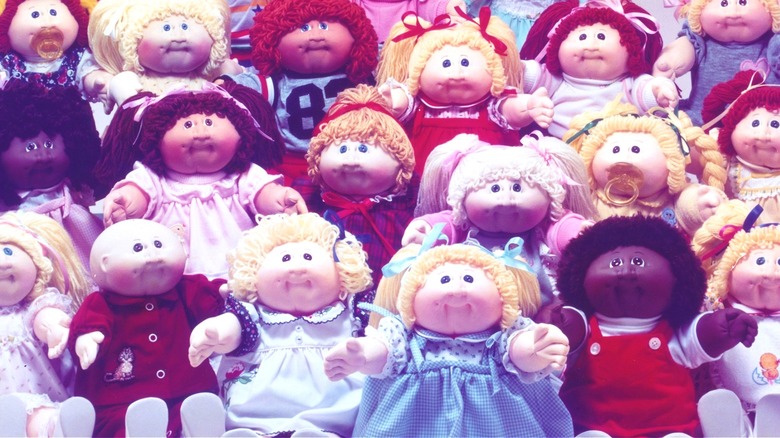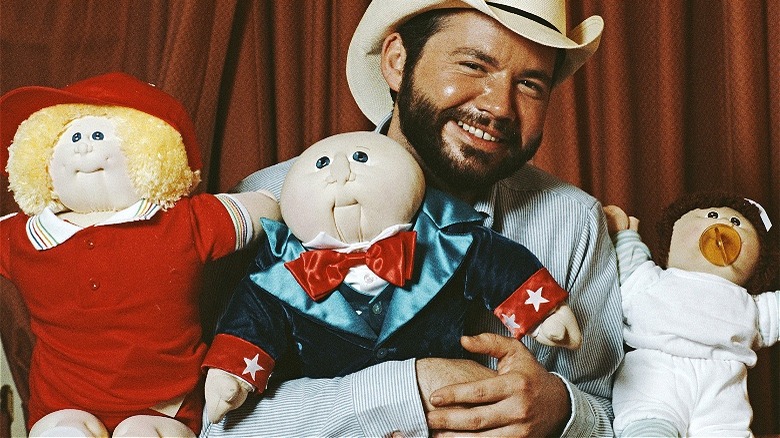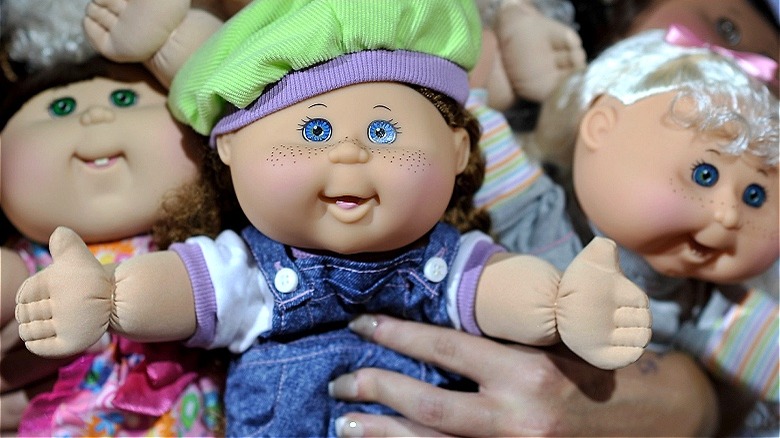Cabbage Patch Kid Dolls That Are Now Worth A Ton Of Money
Into every generation, a toy craze is born. And if it happens to be born in an Appalachian cabbage patch where a Bunnybee can sprinkle it with magic crystal dust, chances are that toy craze will never really die. Cabbage Patch Kids made their debut in 1983, and were wildly popular during the decade. Each doll came with a birth certificate, an adoption paper, outfit, and its own packaging. Demand for these squishy-bodied, hard-faced kiddos even inspired the first toy-shopping riots. While there might be less violent enthusiasm for Mother Cabbage's bundles of joy these days, the Cabbage Patch doll and related products remain collectible.
Cabbage Patch Kids that are 40 years old have sold for about $50 to $6,000. Not bad for dolls that originally retailed for $21. A healthy amount of these dolls are even listed on eBay at resale prices in the hundreds, and as said, even thousands. To give you an idea of the collectability of certain dolls, on November 20, 2021, a 1985 Cabbage Patch Kids All Stars New York Yankees still-in-box doll signed by Mickey Mantle sold for $630 at Heritage Auctions.
However, some resale prices for the dolls seem set too high for the market. For example, a $14,900 buy-it-now vintage 1980s Cabbage Patch Kid has zero watchers on eBay, while another boxed model with a buy-it-now price of $67.49 has 23 watchers (as of this writing). So which Cabbage Patch Kid dolls are actually worth the most money, and why? And, how can you tell if you have one hanging around in your own patch (or hall closet) all these years later?
The doll's age makes a difference
The earliest models weren't called Cabbage Patch Kids at all, but rather "Little People Originals," made of soft fabric with yarn hair and country clothes. They were created by Georgian artist-turned-businessman Xavier Roberts, who, in 1982, agreed to a licensing deal with Coleco; Coleco would mass-produce the dolls starting in 1983.
By the end of 1983, the Little People Originals were the subject of a copyright controversy, with another artist, Martha Nelson Thomas, claiming Roberts took her idea. She sued him for $1 million over the dolls' design, as reported by The Christian Science Monitor at the time. Ultimately, the case was settled out of court, but these Little People Originals are notably the priciest collectibles in the cabbage patch today. For example, a 1979 model of a boy with red hair sold at auction in 2024 for $9,500, while another from 1979, a redheaded girl in a party dress, sold for $7,000. Given that all these dolls were made by Roberts himself, and have his signature to prove it, adds considerably to their value.
Mattel started manufacturing the dolls in 1995, and some of these first editions are true collector's items, especially if they have a sought-after skin color. These dolls can sell for $1,000 to $6,000 at auction. Limited-edition dolls also generate more value in the collectors' market, like dolls with the "brat"-style dimpled face model, or short-run styles like the Splash N' Tan and Olympikids dolls.
How to tell if your doll is valuable
While the unexpected value of Barbies can be traced to rare models, the value of retro video games to their pristine packaging, and the worth of McDonald's Happy Meal toys to nostalgia, the value of Cabbage Patch Kids is an entirely different ball of cabbage leaves. As stated on the official Cabbage Patch Kids website, "There are literally hundreds of thousands of different Cabbage Patch Kids that have been delivered in the past 30-plus years making it impossible for us to monitor individual values."
Of course, certain mint-condition models that are complete with their adoption paper and birth certificate are going to be the most valuable. But there are other signs of value. Check tags on dolls and clothing for a "J" for Jesmar, a desirable-to-collectors factory in Spain. Also check for Triang Pedigree information, a South African factory; note that the eye paint on Triang Pedigree dolls will be a bit cloudy. Collectors also search for dolls with "popcorn" hair: a specific style of yarn curls. The #19 and #17 head molds are also sought after by Cabbage Patch Kids collectors, and can be confirmed by looking for those numbers on the back of a doll's head.
The Designer Line dolls, meanwhile, are valuable for their cute, oh-so-'90s clothes, as well as for their transitional status. In 1989, Hasbro took over manufacturing from Coleco, yet both companies produced Designer Line items during this time — which collectors love to hunt down for their own stylin' and profilin' cabbage patches.


